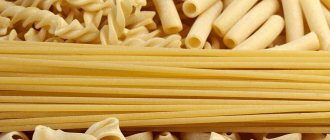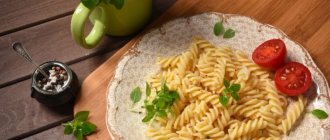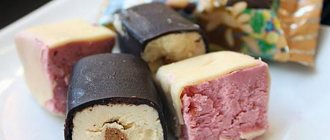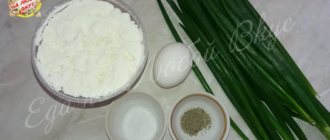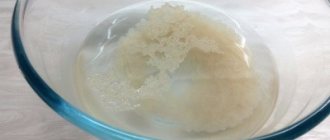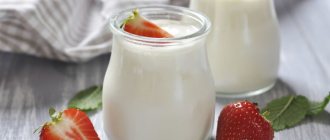Pasta
Pasta products are characterized by high nutritional value, good digestibility, simplicity and speed of preparing dishes from them. The composition of pasta includes (in%): digestible carbohydrates - 70-79, proteins - 9-13, fats - about 1.0, minerals - 0.5-0.9, fiber - 0.1-0.6 , moisture - up to 13. The energy value is on average 1.5-103 kJ per 100 g. Their nutritional value depends on the type of flour and fortification additives.
One of the main directions for the development of pasta production should be considered the creation of products with a balanced composition of amino acids, vitamins and minerals. In accordance with the standards of a balanced diet, for the most complete absorption by the body, it is necessary that the ratio of proteins and carbohydrates be 25%. Therefore, pasta products, which contain an average of 12% protein, can additionally add the same amount.
Pasta products contain insufficient amounts of essential amino acids such as lysine, methionine, threonine. With the introduction of egg products, the content increases significantly.
Pasta products for dietary and baby food include Enriched semolina - small pasta inna semolina. Casecit, iron glycerophosphate, vitamins B1, B2, PP are added as additives to the wheat flour of these products. The enriched cereal has a pleasant taste, a yellowish-cream color due to the use of vitamins, an increased protein content (by 20%) and an improved amino acid composition. It is recommended for preparing milk porridges and soups instead of semolina and differs from it not only in its high biological value, but also in the speed of preparation (3-5 instead of 12-15 minutes). This allows you to preserve the added substances as much as possible.
Protein-free products are made on the basis of corn and swelling amylopectin phosphate starch with the addition of fortifiers. They are formed in the form of noodles enriched with calcium glycerophosphate, grains enriched with B complex vitamins and iron glycerophosphate. Protein-free products are intended for feeding children with phenylcotonuria and adults requiring a hypoprotein and gluten-free diet due to renal failure. Protein-free pasta is white and mealy when broken. When cooked, they become transparent, retain their shape and elasticity.
Pasta products Artek, Zdorovye, School made from premium flour have increased biological value due to the use of fortifying additives - egg and dairy products. They contain 15-20% more protein and 30% more lysine than unfortified products.
Artek contains egg products, semi-fat or dietary cottage cheese; Health - casecite or milk protein, group B vitamins and minerals; School - egg powder or other egg products in combination with dry whole or skim milk. School, Health and Artek pasta products are produced in the form of stamped figures (surprise, bow) or pressed soup fillings (rings, clover, forget-me-not, alphabet, etc.), as well as in the form of short-cut thin vermicelli and narrow noodles. Pasta prepared with various types of vegetable additives: tomato, spinach, carrots, have an improved mineral composition. Abroad, much attention is paid to instant pasta. They usually have a porous structure and are shaped like noodles. Products prepared in various ways and with various enrichment additives do not require cooking; it is enough to pour hot water over them before use.
- Back
- Forward
Calorie content of Pasta. Chemical composition and nutritional value.
Nutritional value and chemical composition of “Pasta”.
The table shows the nutritional content (calories, proteins, fats, carbohydrates, vitamins and minerals) per 100 grams of edible portion.
| Nutrient | Quantity | Norm** | % of the norm in 100 g | % of the norm in 100 kcal | 100% normal |
| Calorie content | 346 kcal | 1684 kcal | 20.5% | 5.9% | 487 g |
| Squirrels | 12.5 g | 76 g | 16.4% | 4.7% | 608 g |
| Fats | 1.1 g | 56 g | 2% | 0.6% | 5091 g |
| Carbohydrates | 71.5 g | 219 g | 32.6% | 9.4% | 306 g |
| Alimentary fiber | 3 g | 20 g | 15% | 4.3% | 667 g |
| Water | 8.21 g | 2273 g | 0.4% | 0.1% | 27686 g |
| Ash | 1.62 g | ~ | |||
| Vitamins | |||||
| Vitamin B1, thiamine | 0.407 mg | 1.5 mg | 27.1% | 7.8% | 369 g |
| Vitamin B2, riboflavin | 0.218 mg | 1.8 mg | 12.1% | 3.5% | 826 g |
| Vitamin B5, pantothenic | 0.87 mg | 5 mg | 17.4% | 5% | 575 g |
| Vitamin B6, pyridoxine | 0.283 mg | 2 mg | 14.2% | 4.1% | 707 g |
| Vitamin B9, folates | 69 mcg | 400 mcg | 17.3% | 5% | 580 g |
| Vitamin E, alpha tocopherol, TE | 0.46 mg | 15 mg | 3.1% | 0.9% | 3261 g |
| beta tocopherol | 0.22 mg | ~ | |||
| gamma tocopherol | 0.87 mg | ~ | |||
| Vitamin K, phylloquinone | 1.4 mcg | 120 mcg | 1.2% | 0.3% | 8571 g |
| Vitamin RR, NE | 8.691 mg | 20 mg | 43.5% | 12.6% | 230 g |
| Macronutrients | |||||
| Potassium, K | 434 mg | 2500 mg | 17.4% | 5% | 576 g |
| Calcium, Ca | 29 mg | 1000 mg | 2.9% | 0.8% | 3448 g |
| Magnesium, Mg | 128 mg | 400 mg | 32% | 9.2% | 313 g |
| Sodium, Na | 5 mg | 1300 mg | 0.4% | 0.1% | 26000 g |
| Sera, S | 138.7 mg | 1000 mg | 13.9% | 4% | 721 g |
| Phosphorus, P | 343 mg | 800 mg | 42.9% | 12.4% | 233 g |
| Microelements | |||||
| Iron, Fe | 3.62 mg | 18 mg | 20.1% | 5.8% | 497 g |
| Manganese, Mn | 2.983 mg | 2 mg | 149.2% | 43.1% | 67 g |
| Copper, Cu | 497 mcg | 1000 mcg | 49.7% | 14.4% | 201 g |
| Selenium, Se | 77.6 mcg | 55 mcg | 141.1% | 40.8% | 71 g |
| Zinc, Zn | 2.97 mg | 12 mg | 24.8% | 7.2% | 404 g |
| Digestible carbohydrates | |||||
| Starch and dextrins | 56.75 g | ~ | |||
| Mono- and disaccharides (sugars) | 2.74 g | max 100 g | |||
| Glucose (dextrose) | 0.24 g | ~ | |||
| Maltose | 1.52 g | ~ | |||
| Sucrose | 0.68 g | ~ | |||
| Fructose | 0.3 g | ~ | |||
| Fatty acid | |||||
| Trans fats | 0.002 g | max 1.9 g | |||
| Saturated fatty acids | |||||
| Saturated fatty acids | 0.428 g | max 18.7 g | |||
| 14:0 Miristinovaya | 0.005 g | ~ | |||
| 15:0 Pentadecane | 0.004 g | ~ | |||
| 16:0 Palmitinaya | 0.374 g | ~ | |||
| 17:0 Margarine | 0.002 g | ~ | |||
| 18:0 Stearic | 0.032 g | ~ | |||
| 20:0 Arakhinovaya | 0.004 g | ~ | |||
| 22:0 Begenovaya | 0.004 g | ~ | |||
| 24:0 Lignoceric | 0.004 g | ~ | |||
| Monounsaturated fatty acids | 0.361 g | min 16.8 g | 2.1% | 0.6% | |
| 16:1 Palmitoleic | 0.003 g | ~ | |||
| 16:1 cis | 0.003 g | ~ | |||
| 17:1 Heptadecene | 0.001 g | ~ | |||
| 18:1 Oleic (omega-9) | 0.34 g | ~ | |||
| 18:1 cis | 0.34 g | ~ | |||
| 20:1 Gadoleic (omega-9) | 0.013 g | ~ | |||
| 22:1 Erucic (omega-9) | 0.002 g | ~ | |||
| 22:1 cis | 0.002 g | ~ | |||
| 24:1 Nervonic, cis (omega-9) | 0.001 g | ~ | |||
| Polyunsaturated fatty acids | 1.136 g | from 11.2 to 20.6 g | 10.1% | 2.9% | |
| 18:2 Linolevaya | 1.063 g | ~ | |||
| 18:2 trans isomer, undetermined | 0.002 g | ~ | |||
| 18:2 Omega-6, cis, cis | 1.061 g | ~ | |||
| 18:3 Linolenic | 0.07 g | ~ | |||
| 18:3 Omega-3, alpha-linolenic | 0.07 g | ~ | |||
| 20:2 Eicosadiene, Omega-6, cis, cis | 0.002 g | ~ | |||
| 20:4 Arachidonic | 0.001 g | ~ | |||
| Omega-3 fatty acids | 0.07 g | from 0.9 to 3.7 g | 7.8% | 2.3% | |
| Omega-6 fatty acids | 1.064 g | from 4.7 to 16.8 g | 22.6% | 6.5% |
The energy value of Pasta is 346 kcal.
Primary Source: Created in the application by the user. Read more.
** This table shows the average levels of vitamins and minerals for an adult. If you want to know the norms taking into account your gender, age and other factors, then use the “My Healthy Diet” application.
Without fear of extra pounds
Followers of dietary nutrition are well aware of the high calorie content of cheese. Therefore, our tasty and healthy dish can easily do without this component. The finished dish can be consumed immediately; it is most often served for lunch.
The recipe for this dish is perfectly balanced. Vegetable fiber, vegetable protein of spinach and hard cheese, wheat sprouts enriched with flavonoids, vitamins and carbohydrates of pasta organically complement and compensate for each other. This dish is organic, aesthetically pleasing and complete and is suitable for both gourmets and aesthetes, and as a dietary variety. Well, for those who like separate meals, we can advise replacing butter in the recipe with olive or sunflower oil.
Pasta: product composition. Vitamins and minerals
Before we look at a detailed list of chemical elements contained in the presented product, let's talk about things like choline, which accounts for 52.5 mg in 1 kg of dry pasta. This substance has a beneficial effect on the human nervous system, is an antidepressant, normalizes fat metabolism in the body, can protect tissue cell membranes from destruction, and also reduces cholesterol levels in the blood.
- B vitamins (folic acid, riboflavin, thiamine, pyridoxine, and pantothenic acid);
- vitamins of group E;
- vitamins P (including niacin equivalent);
- biotin;
- choline
The list of minerals contained in the product is represented by such useful chemical elements as:
- potassium (123 mg);
- calcium (19 mg);
- sodium;
- magnesium (16 mg);
- iron (1.6 mg);
- zinc;
- copper (700 mcg);
- sulfur (71 mg) and others.
Product calorie analysis
SHARE OF BZHU IN CALORIES
Ratio of proteins, fats and carbohydrates:
Knowing the contribution of proteins, fats and carbohydrates to calorie content, you can understand how well a product or diet meets the standards of a healthy diet or the requirements of a certain diet. For example, the US and Russian Departments of Health recommend 10-12% of calories come from protein, 30% from fat and 58-60% from carbohydrates. The Atkins diet recommends low carbohydrate intake, although other diets focus on low fat intake.
If more energy is expended than it is received, the body begins to use up fat reserves, and body weight decreases.
- Vitamin PP
is involved in redox reactions of energy metabolism. Insufficient vitamin intake is accompanied by disruption of the normal condition of the skin, gastrointestinal tract and nervous system. - Silicon
is included as a structural component in glycosaminoglycans and stimulates collagen synthesis. - Cobalt
is part of vitamin B12. Activates enzymes of fatty acid metabolism and folic acid metabolism. - Manganese
is involved in the formation of bone and connective tissue, and is part of enzymes involved in the metabolism of amino acids, carbohydrates, and catecholamines; necessary for the synthesis of cholesterol and nucleotides. Insufficient consumption is accompanied by slower growth, disturbances in the reproductive system, increased fragility of bone tissue, and disturbances in carbohydrate and lipid metabolism. - Copper
is part of enzymes that have redox activity and are involved in the metabolism of iron, stimulates the absorption of proteins and carbohydrates. Participates in the processes of providing oxygen to the tissues of the human body. Deficiency is manifested by disturbances in the formation of the cardiovascular system and skeleton, and the development of connective tissue dysplasia. - Molybdenum
is a cofactor for many enzymes that ensure the metabolism of sulfur-containing amino acids, purines and pyrimidines.
more hide
Energy value, or calorie content
- this is the amount of energy released in the human body from food during the digestion process. The energy value of the product is measured in kilocalories (kcal) or kilojoules (kJ) per 100 grams. product. The kilocalorie used to measure the energy value of food is also called a food calorie, so when caloric content is reported in (kilo)calories, the prefix kilo is often omitted. You can see detailed energy value tables for Russian products.
The nutritional value
— content of carbohydrates, fats and proteins in the product.
Nutritional value of food product
- a set of properties of a food product, in the presence of which the physiological needs of a person for the necessary substances and energy are satisfied.
Vitamins
, organic substances required in small quantities in the diet of both humans and most vertebrates. Vitamin synthesis is usually carried out by plants, not animals. A person's daily requirement for vitamins is only a few milligrams or micrograms. Unlike inorganic substances, vitamins are destroyed by strong heat. Many vitamins are unstable and are “lost” during cooking or food processing.
Pasta is rightfully considered one of the most beloved and sought-after products on our entire planet. The composition of the ingredient includes almost all the valuable vitamins and microelements that a person needs for full life. It will be useful to know the calorie content of the presented product for those who adhere to a rational and balanced diet.
